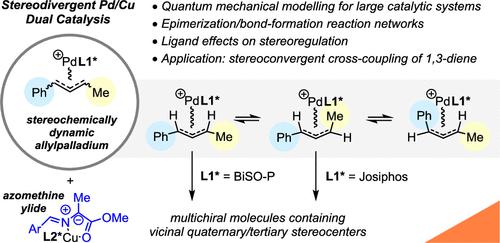当前位置:
X-MOL 学术
›
ACS Catal.
›
论文详情
Our official English website, www.x-mol.net, welcomes your
feedback! (Note: you will need to create a separate account there.)
Ligand Effects on Isomerization/Bond-Formation Networks in Stereodivergent Pd/Cu Dual Catalysis Involving Stereochemically Dynamic Allylpalladium Intermediates
ACS Catalysis ( IF 11.3 ) Pub Date : 2023-10-26 , DOI: 10.1021/acscatal.3c03532
Bo Li 1, 2, 3 , Qinglong Zhang 2 , Weiwei Zi 2 , Yanfeng Dang 1
ACS Catalysis ( IF 11.3 ) Pub Date : 2023-10-26 , DOI: 10.1021/acscatal.3c03532
Bo Li 1, 2, 3 , Qinglong Zhang 2 , Weiwei Zi 2 , Yanfeng Dang 1
Affiliation

|
Recent advancements in enantio-/diastereodivergent dual catalysis are greatly empowered by stereochemically dynamic metal-allyl species. These in situ generated stereochemical mixtures span a highly convoluted network of isomerization and bond-formation pathways. While elucidation of these networks can offer valuable insights that aid the design of more efficient and controllable reactions utilizing stereochemically dynamic species as versatile intermediates, such a task has challenged both experiments and computations due to the combinatorial complexity and transient nature of the allylpalladium(II). Here, we report extensive computational studies with experimental validation that together provide full isomerization/bond-formation networks for two recent systems of stereodivergent Pd/Cu dual catalysis. We show that allylpalladium(II) can undergo a number of isomerization processes prior to C(sp3)–C(sp3) formation, and diastereoselection over the resulting diastereomeric mixture consisting of multiple syn-/anti-allylpalladium is independent of the copper-bound nucleophile. Moreover, critical ligand control over the stereochemical composition of allylpalladium(II) is disclosed, which is reliant upon the detailed positioning of ligand steric hindrance. Surprisingly, such an effect is crucial for the diastereoselection in a Pd/Cu dual-catalytic cross-coupling of 1,3-diene with aldimine esters. The studies showcase how variations in ligand structures cause distinct reaction flows in the reaction networks of Pd/Cu dual catalysis through the lens of network-level computational analysis.
中文翻译:

涉及立体化学动态烯丙基钯中间体的立体发散 Pd/Cu 双催化中配体对异构化/成键网络的影响
立体化学动态金属烯丙基物质极大地促进了对映/非对映发散双重催化的最新进展。这些原位生成的立体化学混合物跨越了高度复杂的异构化和成键途径网络。虽然阐明这些网络可以提供有价值的见解,帮助设计利用立体化学动态物种作为多功能中间体的更有效和可控的反应,但由于烯丙基钯(II)的组合复杂性和瞬态性质,这项任务对实验和计算都提出了挑战。 。在这里,我们报告了广泛的计算研究和实验验证,这些研究共同为两个最近的立体发散 Pd/Cu 双催化系统提供了完整的异构化/成键网络。我们证明烯丙基钯(II)在C(sp 3 )–C(sp 3 )形成之前可以经历许多异构化过程,并且由多个顺式/反式烯丙基钯组成的非对映异构体混合物的非对映选择与铜无关-结合亲核试剂。此外,还公开了配体对烯丙基钯(II)立体化学组成的关键控制,这依赖于配体空间位阻的详细定位。令人惊讶的是,这种效应对于 1,3-二烯与醛亚胺酯的 Pd/Cu 双催化交叉偶联中的非对映选择至关重要。这些研究通过网络级计算分析的视角展示了配体结构的变化如何导致 Pd/Cu 双催化反应网络中不同的反应流。
更新日期:2023-10-26
中文翻译:

涉及立体化学动态烯丙基钯中间体的立体发散 Pd/Cu 双催化中配体对异构化/成键网络的影响
立体化学动态金属烯丙基物质极大地促进了对映/非对映发散双重催化的最新进展。这些原位生成的立体化学混合物跨越了高度复杂的异构化和成键途径网络。虽然阐明这些网络可以提供有价值的见解,帮助设计利用立体化学动态物种作为多功能中间体的更有效和可控的反应,但由于烯丙基钯(II)的组合复杂性和瞬态性质,这项任务对实验和计算都提出了挑战。 。在这里,我们报告了广泛的计算研究和实验验证,这些研究共同为两个最近的立体发散 Pd/Cu 双催化系统提供了完整的异构化/成键网络。我们证明烯丙基钯(II)在C(sp 3 )–C(sp 3 )形成之前可以经历许多异构化过程,并且由多个顺式/反式烯丙基钯组成的非对映异构体混合物的非对映选择与铜无关-结合亲核试剂。此外,还公开了配体对烯丙基钯(II)立体化学组成的关键控制,这依赖于配体空间位阻的详细定位。令人惊讶的是,这种效应对于 1,3-二烯与醛亚胺酯的 Pd/Cu 双催化交叉偶联中的非对映选择至关重要。这些研究通过网络级计算分析的视角展示了配体结构的变化如何导致 Pd/Cu 双催化反应网络中不同的反应流。

































 京公网安备 11010802027423号
京公网安备 11010802027423号